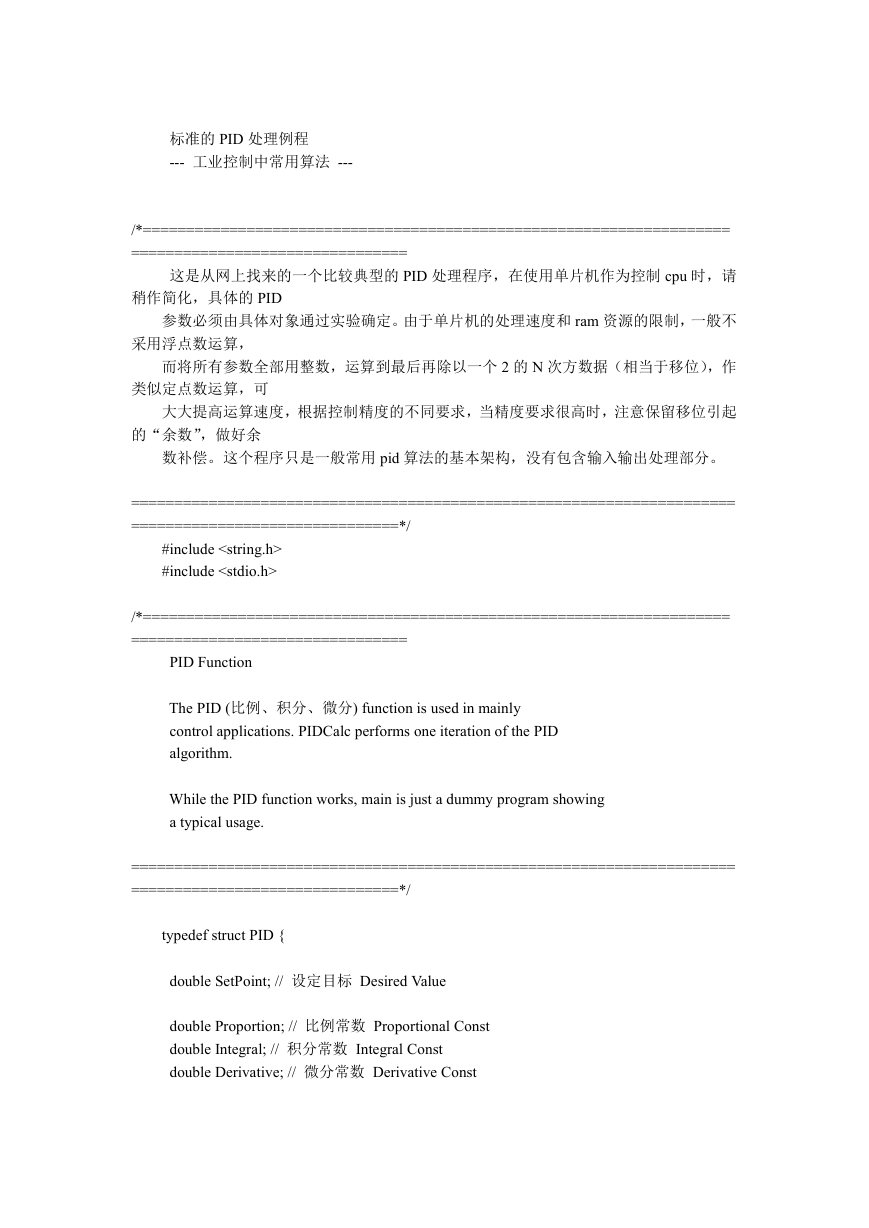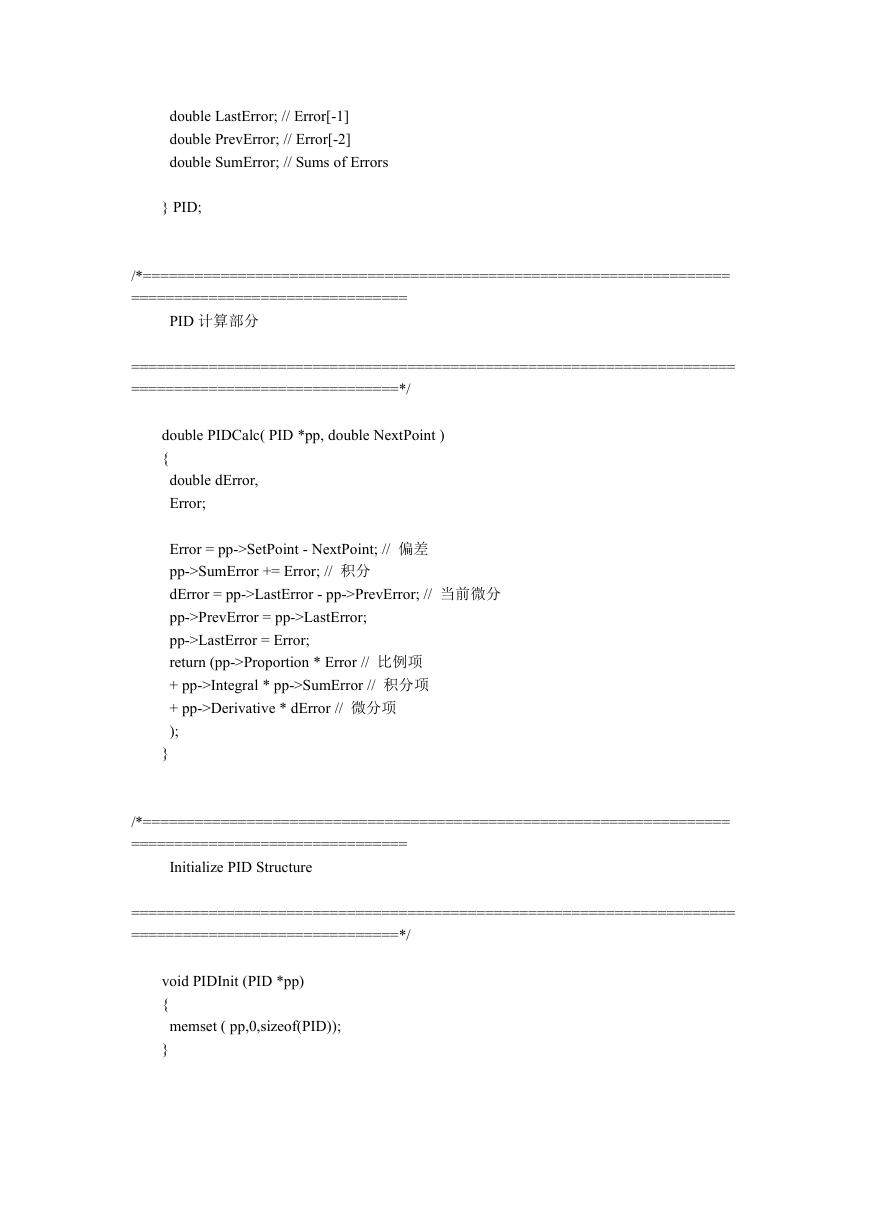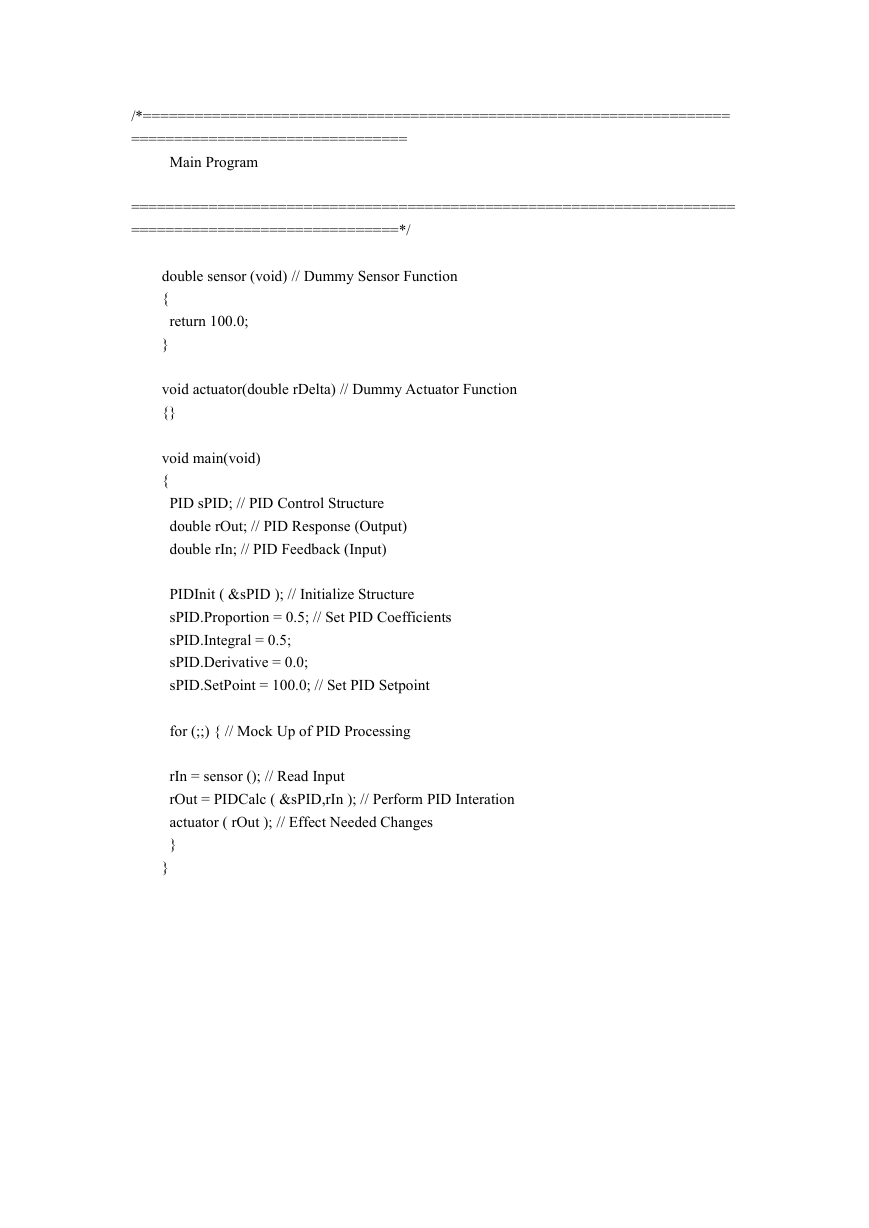标准的 PID 处理例程
--- 工业控制中常用算法 ---
/*====================================================================
================================
这是从网上找来的一个比较典型的 PID 处理程序,在使用单片机作为控制 cpu 时,请
稍作简化,具体的 PID
参数必须由具体对象通过实验确定。由于单片机的处理速度和 ram 资源的限制,一般不
采用浮点数运算,
而将所有参数全部用整数,运算到最后再除以一个 2 的 N 次方数据(相当于移位),作
类似定点数运算,可
大大提高运算速度,根据控制精度的不同要求,当精度要求很高时,注意保留移位引起
的“余数”,做好余
数补偿。这个程序只是一般常用 pid 算法的基本架构,没有包含输入输出处理部分。
======================================================================
===============================*/
#include
#include
/*====================================================================
================================
PID Function
The PID (比例、积分、微分) function is used in mainly
control applications. PIDCalc performs one iteration of the PID
algorithm.
While the PID function works, main is just a dummy program showing
a typical usage.
======================================================================
===============================*/
typedef struct PID {
double SetPoint; // 设定目标 Desired Value
double Proportion; // 比例常数 Proportional Const
double Integral; // 积分常数 Integral Const
double Derivative; // 微分常数 Derivative Const
�
double LastError; // Error[-1]
double PrevError; // Error[-2]
double SumError; // Sums of Errors
} PID;
/*====================================================================
================================
PID 计算部分
======================================================================
===============================*/
double PIDCalc( PID *pp, double NextPoint )
{
double dError,
Error;
Error = pp->SetPoint - NextPoint; // 偏差
pp->SumError += Error; // 积分
dError = pp->LastError - pp->PrevError; // 当前微分
pp->PrevError = pp->LastError;
pp->LastError = Error;
return (pp->Proportion * Error // 比例项
+ pp->Integral * pp->SumError // 积分项
+ pp->Derivative * dError // 微分项
);
}
/*====================================================================
================================
Initialize PID Structure
======================================================================
===============================*/
void PIDInit (PID *pp)
{
memset ( pp,0,sizeof(PID));
}
�
/*====================================================================
================================
Main Program
======================================================================
===============================*/
double sensor (void) // Dummy Sensor Function
{
return 100.0;
}
void actuator(double rDelta) // Dummy Actuator Function
{}
void main(void)
{
PID sPID; // PID Control Structure
double rOut; // PID Response (Output)
double rIn; // PID Feedback (Input)
PIDInit ( &sPID ); // Initialize Structure
sPID.Proportion = 0.5; // Set PID Coefficients
sPID.Integral = 0.5;
sPID.Derivative = 0.0;
sPID.SetPoint = 100.0; // Set PID Setpoint
for (;;) { // Mock Up of PID Processing
rIn = sensor (); // Read Input
rOut = PIDCalc ( &sPID,rIn ); // Perform PID Interation
actuator ( rOut ); // Effect Needed Changes
}
}
�






 2023年江西萍乡中考道德与法治真题及答案.doc
2023年江西萍乡中考道德与法治真题及答案.doc 2012年重庆南川中考生物真题及答案.doc
2012年重庆南川中考生物真题及答案.doc 2013年江西师范大学地理学综合及文艺理论基础考研真题.doc
2013年江西师范大学地理学综合及文艺理论基础考研真题.doc 2020年四川甘孜小升初语文真题及答案I卷.doc
2020年四川甘孜小升初语文真题及答案I卷.doc 2020年注册岩土工程师专业基础考试真题及答案.doc
2020年注册岩土工程师专业基础考试真题及答案.doc 2023-2024学年福建省厦门市九年级上学期数学月考试题及答案.doc
2023-2024学年福建省厦门市九年级上学期数学月考试题及答案.doc 2021-2022学年辽宁省沈阳市大东区九年级上学期语文期末试题及答案.doc
2021-2022学年辽宁省沈阳市大东区九年级上学期语文期末试题及答案.doc 2022-2023学年北京东城区初三第一学期物理期末试卷及答案.doc
2022-2023学年北京东城区初三第一学期物理期末试卷及答案.doc 2018上半年江西教师资格初中地理学科知识与教学能力真题及答案.doc
2018上半年江西教师资格初中地理学科知识与教学能力真题及答案.doc 2012年河北国家公务员申论考试真题及答案-省级.doc
2012年河北国家公务员申论考试真题及答案-省级.doc 2020-2021学年江苏省扬州市江都区邵樊片九年级上学期数学第一次质量检测试题及答案.doc
2020-2021学年江苏省扬州市江都区邵樊片九年级上学期数学第一次质量检测试题及答案.doc 2022下半年黑龙江教师资格证中学综合素质真题及答案.doc
2022下半年黑龙江教师资格证中学综合素质真题及答案.doc